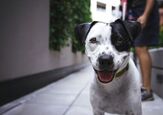Could My Cat’s Drooling Be a Sign of Trouble?

Unlike a dog, drooling is not a normal part of the cat experience. When your cat leaves a damp spot on the lap or on the floor, it’s natural to feel worried. It’s important to recognize that drooling isn’t a standalone diagnosis or condition. Instead, it’s a symptom of trouble that can be associated with a wide spectrum of situations, ranging from a “happy drool” signaling contentment (yes, it can happen) to a medical problem that needs veterinary attention.
To help you distinguish between the two, I will break down the most common explanations for kitty drooling, highlighting which should be considered a cause for concern. Knowing when to simply wipe it away and when to pick up the phone to call your vet can make all the difference in keeping your cat safe, happy, and healthy!
The “Happy Drool”
Before panic sets in, there are a select few very specific situations where a little bit of cat drool is no cause for alarm. Take a moment to consider the details surrounding your cat’s drooling and whether it could definitively be connected with one of the following cases. This type of drooling is typically temporary, mild, and stops immediately once the context changes, allowing you to take a deep breath and relax.
The Purr Drool
Believe it or not, excessive happiness is the most common normal reason a cat will drool, making them not all that different from their canine counterparts.
This behavior is a direct, neurological link back to their kittenhood and the nursing reflex. When kittens nurse, they instinctively knead on their mother’s belly to stimulate milk flow. This action, combined with the satisfaction of a full belly, creates a powerful association. As adults, when a cat feels incredibly safe, content, or loved, it may trigger this same reflex, causing your cat to purr and knead (often referred to as “ making biscuits”), which in turn can stimulate the salivary glands. They could literally be so happy that they forget to swallow.
Purr drooling is almost always accompanied by:
- Loud purring
- Kneading on a soft surface or your lap
- A completely relaxed, blissful expression
- It stops the moment the petting or purring stops
A Stress Response
While this isn’t a happy explanation, it’s still one that brings little overall worry. Feelings of stress, anxiety, and fear can also trigger a similar (and temporary) physical reaction. When feeling a heightened state of anxiety, your cat’s body can release stress hormones that affect the digestive system and salivary glands, causing them to produce more saliva than normal. This increase in saliva may escape their mouth, leading to drooling.
This is most often seen during car rides (due to motion sickness or fear), vet visits, or exposure to loud, sudden noises like thunderstorms and fireworks. The drooling is generally short-lived and will stop once the source of their stress is removed. Watch for other signs of stress, such as wide eyes, flattened ears, excessive vocalization, or hiding.
Bad Tastes or Bitter Medication
Cats have extremely sensitive palates, and anything that is bitter, foul-tasting, or irritating will trigger an immediate flood of saliva to wash the substance out of the mouth. This is a quick defense response, with the body trying to dilute and flush out the unpleasant or irritating substance. It’s likely rooted in the fact that toxins generally have a bitter taste.
If this occurs after your cat has been given liquid medication or an improperly coated pill that tastes bitter, it will stop as soon as they successfully swallow the medication and the taste clears from their mouth. You can try using pleasant forms of medication delivery that help mask the taste, such as pill pocket treats or incorporating a tasty broth. Always check with your veterinarian before mixing your cat's medication with any other substance.
However, if the drooling is prolonged or accompanied by foaming, it shifts from being a benign and inconsequential reaction to a potential sign of toxicity, which I will discuss later.
The “Worry Drool”
If your cat’s drooling is persistent, excessive, new, or accompanied by other signs of trouble, there is a good possibility that it is caused by an underlying health issue. This type of drooling requires a prompt call to your veterinarian so they can do a thorough exam and identify the root cause. Unlike the “Happy Drool,” which is fleeting and linked to emotion, this “Worry Drool” is caused by a physical problem that is either causing them to produce more saliva than usual or preventing them from swallowing saliva normally.
Here are the most common and serious medical explanations for excessive drooling in cats, organized by the body system they affect:
Dental and Oral Disease (The Most Common Culprit)
Experts estimate that anywhere between 50 and 90% of cats over the age of four will suffer from some form of dental disease, making this a surprisingly common struggle. When faced with the pain and irritation caused by dental problems, your cat’s body may produce more saliva to try to soothe the pain. Unfortunately, the pain itself often makes swallowing difficult.
The most common dental problems your cat may be facing include:
- Periodontal Disease and Gingivitis: Inflammation and infection of the gums and supporting structures of the teeth can cause chronic pain and irritation, leading to drooling.
- Feline Odontoclastic Resorptive Lesions (FORLs): These are extremely painful erosions of the tooth structure, often at the gum line. They are equivalent to severe cavities and can cause very painful sensitivity, as well as excessive salivation.
- Oral Ulcers and Infections: Sores in the mouth caused by chronic diseases (like advanced kidney failure) or acute infections (like feline calicivirus) are excruciatingly painful and lead to constant drooling.
- Oral Trauma: Injuries such as a fractured tooth, a cut on the cheek or tongue, or a broken jaw from an accident or a cat fight will cause pain and an inability to properly close the mouth, causing your cat to drool.
If your cat’s drooling is caused by oral pain, you may notice they have developed noticeable bad breath or started to show unexplained weight loss. Due to pain and discomfort, they may be reluctant to eat (especially dry or crunchy food) or may drop food from their mouth while eating. Any of these warning signs warrants a vet visit.
Foreign Objects and Obstruction
Cats are curious creatures who tend to investigate the world around them with their mouths. While this is usually harmless, it can lead to trouble.
A piece of bone, a small toy fragment, or even a blade of grass can become lodged between the teeth, in the roof of the mouth, or at the back of the throat. If a non-food item gets stuck like this, it can cause immediate and panicked drooling as the cat attempts to free themselves from it.
If your cat is comfortable with you handling their mouth, you may be able to remove the foreign object. A cat toothbrush may help with this process, depending on where in the mouth it’s stuck.
In more serious situations, your cat may be dealing with a linear foreign body. This means a piece of string, thread, or yarn is hanging from their mouth or under the tongue. If they have swallowed part of it, the string can cut through their intestines as the gut attempts to pass it unsuccessfully. Never pull on a strong you see hanging from your cat’s mouth or hind end. This should be treated as a medical emergency.
Other signs to watch for that could indicate an obstruction include sudden, frantic drooling, gagging, retching, coughing, or repeatedly pawing at their face or rubbing their face on the ground.
Exposure to Toxins and Poisons
If the drooling starts suddenly and is excessive or foamy, especially if your cat has been outside or near household products, it may be a sign of toxic exposure. The excess saliva, causing your cat to drool, is the body’s attempt to flush the irritant away. This could include:
- Ingestion of Caustic Substances: Household cleaners, detergents, or certain chemicals can cause chemical burns in the mouth and esophagus, leading to intense pain and drooling.
- Toxic Plants: Ingestion of certain houseplants (like lilies, sago palms, or peace lilies) is extremely toxic and can cause an immediate increase in saliva.
- Human Medications: Many common human medications (like NSAIDs or acetaminophen) are highly toxic to cats and can cause an immediate adverse reaction, including drooling.
- Topical Toxins: Even licking flea or tick products intended for dogs (which contain permethrin) or walking through a pesticide and then grooming can cause severe drooling due to toxicity.
Toxicity, regardless of the toxin responsible, is an immediate emergency. Other signs to watch out for include foaming at the mouth, vomiting, diarrhea, severe lethargy, disorientation, tremors, and visible redness, burns, or sores in the mouth.
Nausea and Systemic Illnesses
Drooling is one of the classic signs of nausea in a cat, just as it is in a human. This can be caused by a minor tummy ache or, more concerningly, a serious underlying illness. Simple issues, such as hairballs, a sudden dietary change, or eating something that disagrees with them, can cause temporary nausea and drooling.
Chronic diseases like kidney or liver failure cause toxins to build up in the bloodstream. These toxins not only cause generalized nausea but can also create painful ulcers on the lining of the mouth, throat, and stomach, which drastically increase drooling.
Other signs associated with nausea that you may see include frequent lip-licking, vomiting, retching, loss of appetite, changes in water intake and urination (often increased with kidney disease), or jaundice (yellowing of the eyes/skin due to liver issues).
Severe Neurological and Other Conditions
While less common, excessive drooling can also be a symptom of a few other significant health issues.
Any abnormal mass or growth in the mouse can interfere with your cat’s ability to swallow or simply irritate the tissue, leading to persistent drooling. This could be a benign growth or an oral tumor, highlighting the importance of testing to determine the cause of the problem.
Conditions that affect the nerves controlling your cat’s swallowing reflex could also prevent them from properly managing their saliva, resulting in drooling.
Finally, in high temperatures, a cat may drool or even pant in an attempt to cool down. Unlike dogs, panting is not normal for a cat. This is a sign that your cat is not just hot, but could be at risk of heatstroke, which can be a life-threatening emergency.
When A Vet Visit is Absolutely Needed
Recognizing the distinction between a “Happy Drool” and a “Worry Drool” is critical, but the most important step for a loving cat parent is knowing when to act. Cats are so good at hiding any sign of illness or pain, making any suspicious drooling a potential warning sign that should be taken seriously.
If you notice any of the following signs of serious trouble, contact your vet or the nearest emergency vet immediately:
- Sudden, profuse, or foamy drooling
- Difficulty breathing or open-mouth breathing
- Frantic pawing at their mouth or other obvious signs of panic
- Disorientation or confusion
- Weakness or inability to stand
- Collapse
Decoding the Drool
Any significant change in your cat’s behavior is a cause for concern. Drooling is one of those symptoms that can be either an adorable little quirk or a critical alarm bell. This is why it’s so important to learn to recognize the reason for your cat’s new, damp habit.
If the drooling is mild and clearly linked to a moment of happiness and contentment (such as purring or kneading) or a bad taste, you can relax. However, if their drooling is sudden, persistent, excessive, or accompanied by any other symptom of illness, it’s a call to action.
Cats are masters of disguise, and drooling may be the clearest signal that they are in pain or suffering from a serious condition. Never hesitate to call your veterinarian. Early diagnosis is the most effective way to ensure they continue to enjoy the best possible quality of life.
Join the PetGuide community. Get the latest pet news and product recommendations by subscribing to our newsletter here.

Britt Kascjak is a proud pet mom, sharing her heart (and her home) with her “pack” which includes her husband John, their 2 dogs – Lucifer and Willow – and their 3 cats – Pippen, Jinx, and Theia. She has been active in the animal rescue community for over 15 years, volunteering, fostering and advocating for organizations across Canada and the US. In her free time, she enjoys traveling around the country camping, hiking, and canoeing with her pets.
More by Britt
























